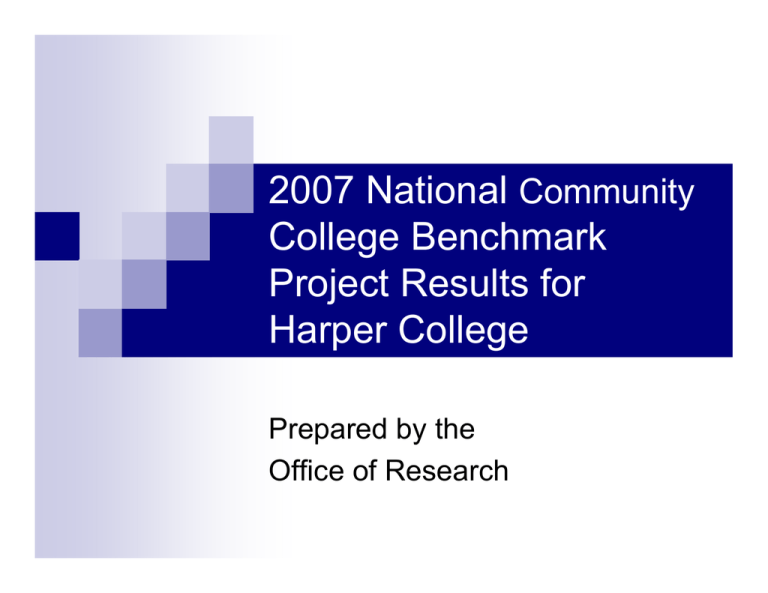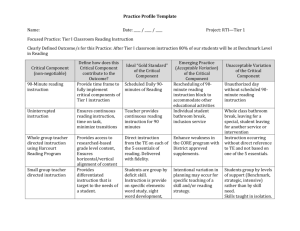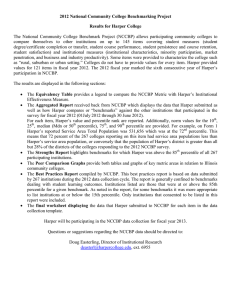2007 National College Benchmark Project Results for Harper College
advertisement

2007 National Community College Benchmark Project Results for Harper College Prepared by the Office of Research Notice to viewers The National Community College Benchmark Project results are for internal use only. If you wish to view the actual report, please contact Laura Crane via email (lcrane@harpercollege.edu) or phone (6955). Thank you! 2 Why Benchmark? “Higher education institutions continue to face increasing demands for accountability, primarily through assessment of institutional effectiveness and student learning outcomes. A major component of these accountability and assessment processes is the ability to use comparative data from other organizations to develop standards of performance or benchmarks. Benchmarking provides important context information for assessing an institution’s effectiveness and performance. Benchmarking helps institutions set performance targets.” Harlan Schweer, “Balanced Scorecards and Benchmark Data” presented at the National Community College Benchmarking Conference, August 1-3, 2006 3 Why Should Harper Benchmark? PREPARE FOR THE FUTURE Understand where we are in comparison with other future oriented community colleges. Ensure Harper is ahead of the curve when national standards are adopted. (Spellings commission…) *www.nccbp.org 4 Why Should Harper Benchmark? To provide strong data to support decisions. (Harper is ranked in bottom quartile in faculty/student interaction – supports strengths initiative.) To identify areas where Harper excels or needs to get better. (Input for plans and starting point with faculty in change discussions.) To support committee work and board exhibits. (Harper is not in the top quartile for tuition and fees.) 5 National Community College Benchmark Project (NCCBP) Implemented in 2004, NCCBP satisfies community colleges’ need for external, comparative data. Over 175 community colleges from across the United States participated in NCCBP in 2007. Subscribers.doc 6 Characteristics of Participating Colleges Characteristics: All Reporting Institutions Institution Type Single-campus: Multi-campus: Multi-college District: Calendar 118 55 5 Campus Environment Primarily Urban: Primarily Suburban: Primarily Rural: Semester: Quarter: Trimester: Other: 171 6 1 96.10% 3.40% 0.60% Faculty Unionized 50 63 65 Yes: No: 97 81 54.50% 45.50% Control Public: Private: 178 7 Peer Group Comparisons Apples to Apples. Selected Peer Group based on similarities in campus setting and student number. Subscribers.doc 8 Characteristics of Peer Group Colleges* Campus Setting Austin Community College City: (TX) Large Suburb: College of DuPage (IL) Large Suburb: College of Lake County (IL) Midsize Suburb: Harper College (IL) Large Johnson County City: Community College (KS) Midsize Mesa Community College City: (AZ) Large Moraine Valley Community Suburb: College (IL) Large City: Richland College (TX) Large Valencia Community City: College (FL) Midsize Student In-District Tuition % Students 24 Population & Fees and Under 33,039 $1,608 61% 26,032 $3,072 54% 15,558 $2,400 51% 15,053 $2,964 61% 19,088 $1,890 65% 25,881 $1,590 62% 15,693 $2,162 63% 14,555 $1,080 58% 30,245 $2,100 71% *College characteristics downloaded from the National Center for Educational Statistics College Navigator site. Tuition and fee costs are for the 2006-07 academic year. 9 Definitions for Peer Group Comparisons Top tier – means among top 3 in peer group. Bottom tier – means among bottom 3 in peer group. Middle tier – means not among top or bottom tier. 10 Student Outcomes Harper in Top Peer Group Tier for: Academic challenge* Active & collaborative learning* Student effort* Support for learners* Completed or transferred in three years (FT) Completed in three years (FT) Transferred in three years (FT) Persistence next-term Persistence fall-to-fall Credit grades % completers (course retention) College-level course retention rate Composition I retention rate Credit grades % withdrawals Developmental Math course retention rate Developmental Reading course retention rate Developmental Writing course retention rate Distance learning % A and B grades Distance learning % completers Distance learning % withdrawals *CCSSE Benchmark scores 11 Student Outcomes Harper in Bottom Peer Group Tier for: Student-faculty interaction* College-level course completer success rate Composition I completer success rate Composition 1 enrollee success rate Composition II completer success rate Speech completer success rate Speech enrollee success rate Credit grades completer success rate Developmental first college-level math completer success rate Developmental first college-level math enrollee success rate Developmental first college-level math retention rate Developmental first college-level writing completer success rate Developmental math completer success rate Developmental reading completer success rate Developmental reading enrollee success rate Developmental writing completer success rate Developmental writing enrollee success rate Distance learning completer success rate *CCSSE Benchmark scores 12 Student Services Staffing Ratios Harper Peer Group Comparisons Top Tier Career Services Counseling & Advising Financial Aid Bottom Tier Admissions & Registration 13 Market Penetration Harper Peer Group Comparisons Top Tier Bottom Tier High school enrollment all high schools Cultural activities Non-credit students Minority student/population ratio 14 Faculty and Staff Harper Peer Group Comparisons Top Tier Training dollars per FTE employee Bottom Tier Faculty load: % sections taught by FT faculty Faculty load: % credit hours taught by FT faculty 15 Institutional Harper Peer Group Comparisons Top Tier Bottom Tier Student/faculty ratio Average credit section size Cost per credit hour Cost per FTE student Distance learning % of credit hours % Minority employees 16 Summary Counts of Peer Group Comparisons Harper was top tier for 27 comparisons. Harper was bottom tier for 27 comparisons. 17 Peer Group Harper is “top tier” Harper is “bottom tier” Course Retention Persistence (Fall-to-Spring, Fall-to-Fall) Employee training dollars FT Student Completion/ Transfers Student Engagement (except student-faculty interaction) Student Services staffing ratios (3) Market penetration Student successful course completion Student-faculty interaction Student-to-faculty ratio Average credit section size % Sections & credit hours taught by FT faculty Student Services staffing ratios (1) Cost/credit hour Cost/student FTE National Sample Persistence (Fall-to-Spring) Employee training dollars FT Student Completed or Transferred Student Services staffing ratios (2) Market penetration Student successful course completion Student-faculty interaction Student-to-faculty ratio Average credit section size % Sections & credit hours taught by FT faculty Rate of employee grievances 18 Using Peer Group and National Comparisons Peer group comparisons are organized into five areas: Student outcomes StudentEngagementGraphs.xls CompletionandTransferRatesGraphs.xls CourseSuccessGraphs.xls Student services StudentServicesGraphs.xls Market penetration MarketPenetrationGraphs.xls Faculty and staff FacultyStaffGraphs.xls Institutional InstitutionalGraphs.xls PeerReport.csv The National Benchmark Report for Harper has been highlighted to show items where Harper excels and where there may be some concerns. Annotated2AggregateReport2007_149842.xls National Community College Benchmark Project 2007 Best Practices Report Copy of NCCBP 2007 Best Practices Report.xls 19 Harper Compared to National Sample Institution Reported Value 25th Service Area Total Population Service Area Unemployment Rate Service Area Median Household Income 514,237 3.67% $66,872 171,799 3.80% $37,198 357,179 4.45% $42,986 676,961 5.60% $51,752 1,318,039 6.90% $66,872 IPEDS Enrollment (Fall 2005) Full-time Credit Headcount (Fall 2005) Part-time Credit Headcount (Fall 2005) 15,026 6,174 8,852 3,602 1,447 1,956 6,049 2,466 3,309 11,298 4,118 6,447 17,437 6,823 10,670 % Transfer Credit Hours (Fall 2005) % Technical/Career Credit Hours (Fall 2005) % Developmental Credit Hours (Fall 2005) 66.21% 16.40% 11.15% 46.45% 22.41% 6.99% 59.90% 31.99% 10.04% 67.93% 42.55% 14.37% 4,321 593 2,898 5,334 Credit Student Median Age (Fall 2005) % Female Credit Students (Fall 2005) % First-generation Student (Fall 2005) 26 56.73% -- 21 55.59% 24.80% 22 58.80% 40.47% 25 61.97% 57.99% 27 64.20% 72.97% % Nonresident Alien (Fall 2005) % Black, Non-Hispanic (Fall 2005) % Am. Indian or Alaskan Native (Fall 2005) % Asian or Pacific Islander (Fall 2005) % Hispanic (Fall 2005) % White, Non-Hispanic (Fall 2005) % Race/Ethnicity Unknown (Fall 2005) 0.59% 3.85% 0.27% 12.39% 14.24% 60.41% 8.27% 0.00% 2.70% 0.26% 0.92% 1.58% 60.63% 1.09% 0.40% 5.55% 0.43% 1.69% 2.65% 77.96% 4.09% 1.11% 10.00% 0.86% 3.19% 10.12% 86.00% 8.44% 2.47% 18.95% 1.91% 6.56% 23.98% 91.17% 13.27% Tuition and Fees per Credit Hour (Fall 2005) Unrestricted Operating Funds (FY 2006) % Funds from Local Sources (FY 2006) % Funds from State (FY 2006) % Funds from Tuition (FY 2006) $93.75 $104,157,182 54.90% 12.34% 32.76% $60 $18,041,010 6.50% 25.00% 25.20% Form 1: Institution Information Non-credit Headcount (Fall 2005) NCCBP Percentiles Mdn 75th $86 $27,284,000 23.00% 33.75% 32.90% $104 $49,016,731 35.92% 49.38% 42.00% 90th 75.54% 54.50% 18.93% 10,512 $125 $81,123,511 62.01% 62.41% 46.00% Percentile ranks, percents of benchmark values that fall below the institution's values, have been omitted for Form20 1 National Community College Benchmark Report for Harper Information in this report is for internal use by the subscribing institution. Subscribing institutions have agreed that this full report, in the format in which it is delivered, will not be shared with or made available to non-subscribers, and that it will not be posted to a public Web site. When viewing report, percentiles from 40 to 60 should be considered about average. AggregateReport2007_149842.xls Annotated2AggregateReport2007_149842.xls 21 Harper’s Best Practice Areas Persistence (Fall-to-Spring) Employee training dollars FT Student completed or transferred Student Services staffing ratios Market penetration 22 Harper’s Biggest Challenges Student successful course completion Student-faculty interaction Student-to-faculty ratio Average credit section size % sections and credit hours taught by FT faculty 23 Moving Forward Determine where data supports current direction and where it suggests reconsideration Strategize biggest challenges Use to support current initiatives Share data Other thoughts ??? 24






